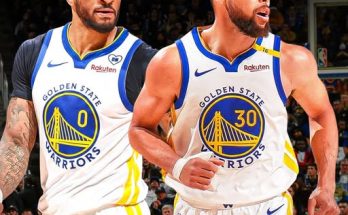The Chicago Bears entered the 2025 NFL Draft with a clear vision for reshaping their offense, and that plan included taking one of the most intriguing tight end prospects the league has seen in years. With the 10th overall pick, they selected Loveland, a player who blends size, speed, and overall athletic ability in ways rarely packaged together at the position. Tight ends in today’s NFL have become more than just blockers or red zone targets—they are versatile weapons capable of dictating matchups, altering defensive schemes, and serving as safety blankets for quarterbacks who need reliable options in pressure situations. Loveland’s selection signaled not just the Bears’ commitment to surrounding their offense with unique talents, but also the growing recognition of how important tight ends have become in shaping modern offenses. Already in preseason, he has validated the hype by proving to be a focal point in Ben Johnson’s new offensive system, which has drawn plenty of attention from both analysts and fantasy football managers.
Loveland’s rise to a top-10 pick was not accidental. His college career was a showcase of dominance, beginning with flashes of potential as a freshman and culminating in a reputation as one of the most complete tight end prospects in a decade. Measuring at 6-foot-5 with a frame that hovers around 250 pounds, Loveland has the kind of size teams dream about when envisioning mismatches against linebackers and safeties. What makes him even more dangerous is his straight-line speed, which pushes the boundaries of what evaluators expect from players at his position. During his pre-draft testing, scouts marveled at his ability to run routes like a wide receiver while maintaining the strength and physicality to hold up in blocking assignments. That combination of traits positioned him not only as a first-round lock but also as someone worthy of going in the top half of the round, where the Bears ultimately grabbed him.
What made the pick even more significant is the direction Chicago’s offense has taken under new head coach Ben Johnson. Coming off his success as the offensive coordinator with the Detroit Lions, Johnson built a reputation as one of the brightest minds in football. He showed an ability to design schemes that maximize talent, often leaning on creative uses of tight ends to create mismatches and dictate coverages. In Detroit, Johnson helped transform Sam LaPorta into one of the league’s most productive tight ends as a rookie. Seeing how that blueprint unfolded, it makes sense why Johnson and the Bears’ front office prioritized landing a player like Loveland, who can be used in similar—and perhaps even more dynamic—ways. From the early looks in preseason, Johnson is not wasting time in establishing Loveland as a central figure in the offense. Whether lined up inline, split wide, or motioned into the backfield, Loveland has shown the kind of versatility that forces defenses to adjust on the fly.
For Chicago’s quarterback situation, having a player like Loveland immediately changes the complexion of the passing game. The Bears have been searching for a consistent offensive identity for years, often struggling to balance their attack and provide a reliable target in critical downs. Wide receivers naturally carry much of the spotlight, but a tight end who can threaten defenses vertically and dominate in contested catch situations provides stability that few teams can replicate. Already, Loveland has developed a noticeable chemistry with his quarterback during the preseason, becoming a frequent target in third-down situations and in the red zone. These reps are not just about confidence but about building trust in high-leverage situations, something Chicago desperately needed to add to its offense.
From a fantasy football perspective, the buzz surrounding Loveland is already heating up. Tight ends are historically one of the most unpredictable positions in fantasy leagues, with only a handful producing consistent week-to-week numbers. That scarcity makes rookies with Loveland’s skill set particularly attractive to fantasy managers looking to find an edge. His ability to run routes like a wide receiver means he could see a target share similar to top-tier pass catchers rather than being limited to occasional dump-offs or red-zone looks. Ben Johnson’s offense is also known for creative scheming that maximizes a tight end’s opportunities, which makes Loveland’s role even more appealing to those setting draft boards. While rookies at the position often take time to adjust to the speed and complexity of NFL defenses, Loveland’s early involvement in the preseason has tempered some of those concerns. Fantasy managers are beginning to see him not just as a developmental stash but as someone who could be an immediate contributor in his first season.
The broader implications of Loveland’s arrival in Chicago extend beyond fantasy football and preseason hype. His selection represents a philosophical shift for the Bears, who are trying to build a sustainable offensive identity after years of inconsistency. Drafting a tight end at 10th overall is not a move teams make lightly—it signifies a belief that this player can be a long-term cornerstone of the offense. In Loveland’s case, his unique blend of athleticism and football IQ makes him a rare talent capable of redefining how the Bears attack defenses. For too long, Chicago’s offense has been reactionary, struggling to dictate terms against aggressive defensive fronts. With Loveland, Johnson now has a weapon who can force defenses into mismatches they cannot easily solve.
Scouts often talk about “uncoverable” players, and while that label is typically reserved for elite wide receivers, Loveland has already started to fit that description in some preseason matchups. Linebackers struggle to keep up with his speed, while defensive backs find themselves outmuscled when contesting throws. This dual-threat capability forces defenses to make difficult choices about personnel packages, often creating opportunities for other playmakers on the field. In this way, Loveland’s presence could have a ripple effect, opening up space for wide receivers and running backs while also giving his quarterback a reliable option when plays break down.
One of the most overlooked aspects of Loveland’s game is his blocking, which remains a vital part of any tight end’s responsibilities. While his athletic gifts in the passing game draw the most attention, his ability to contribute as a run blocker is equally valuable in Johnson’s offense. The Bears are looking to establish a balanced attack, and having a tight end who can set the edge, handle defensive ends, or climb to the second level against linebackers is crucial. Early preseason tape has shown Loveland embracing these responsibilities, further endearing him to coaches and teammates who understand the importance of doing the dirty work in addition to making highlight-reel plays.
Looking ahead to the regular season, the question for Loveland and the Bears is not whether he will be involved, but rather how quickly he can adapt to the grind of a full NFL schedule. Rookies often face challenges with durability, defensive disguises, and the physical toll of a 17-game season. For Loveland, the Bears will need to balance his workload to ensure he remains effective deep into the year. That said, the early signs point to him being one of the most heavily utilized tight ends in the league right out of the gate. If Johnson continues to scheme plays that put him in favorable situations, Loveland could emerge as not just a promising rookie but a potential Pro Bowl candidate as early as his first season.
The excitement around Loveland has also reignited enthusiasm among Bears fans, who have long been hungry for a consistent offensive star. Chicago has a storied history of defensive greatness, but offensive stars have been harder to come by. With Loveland, there is a sense that the team finally has a playmaker who can change games and establish a new identity for the franchise. Fans who have watched him flash in the preseason are already imagining what he can do when the games count, particularly against divisional rivals where the Bears have struggled to keep pace offensively in recent years.
In the bigger picture of the NFL, Loveland’s emergence continues the trend of tight ends becoming central figures in offensive game plans. Just as Travis Kelce, George Kittle, and Mark Andrews have redefined expectations for the position, Loveland enters the league with the potential to be the next in that line of elite, game-changing talents. His draft status reflects the growing recognition of how valuable a truly dynamic tight end can be. If he fulfills even a portion of the expectations placed on him, the Bears will have landed a franchise-altering player with their top-10 pick.
Ultimately, the Bears’ decision to spend such a premium selection on Loveland will be judged by how he performs over the next several years, but the early signs are undeniably positive. His size, speed, and athleticism are rare, his role in Ben Johnson’s offense is already secure, and his impact on both the field and in the fantasy community is immediate. For Chicago, Loveland represents more than just a talented rookie—he is the embodiment of a new direction, a player who can finally give the team the offensive identity it has lacked for so long. If his preseason performance is any indication, the Bears’ investment in him is not only justified but potentially transformative, setting the stage for Loveland to become one of the defining tight ends of his generation.



